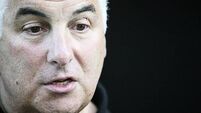Poetry in motion — and all that jazz
DUBLIN-BORN jazz musician Christine Tobin’s ninth album, Sailing to Byzantium, is a re-imagining of a selection of WB Yeats’s best-loved poems.
Tobin’s album won the Contemporary Jazz Composition category at the 2012 British Composer Awards in December.
It is brilliant for her, she says, because “it recognises the writing side, the composition side. This project is the first time I’ve written all of the music but none of the words. It takes me out of the singer-songwriter box and highlights the composing aspect.”
Tobin’s subtle approach and rich and varied palette has allowed her to offer a new and meaningful journey through the poems. Her arrangements are accessible yet consistently interesting without drowning or distorting Yeats’s words. The album marks her out as a natural composer, combining imagination with formal accomplishment.
The award ceremony and performances of the winning music were broadcast by BBC3 and gave Tobin exposure to a whole new audience.
Sailing to Byzantium is essentially a well-formed song cycle, which Tobin describes as “poems set to music”. A quintet of piano, guitar, flutes, cello and bass provide an atmospheric, impressionist soundscape that balances energy with stillness, melody with rhythmic momentum. The recording features the singer’s secondary school teacher, none other than actor Gabriel Byrne, reading three of the poems, including the iconic Lake Isle of Innisfree.
Tobin’s music is tuneful and the words float on the music as if it were the many coloured waters of Yeats’s poems. The Lake Isle of Inisfree is a delicate watercolour, and the familiar words dissolve into simple piano droplets that echo the ripples and the lapping sound of the lake edge. Others, such as The Fisherman, are exotic and playful, while The Second Coming is driven and intense.
Tobin was initially drawn into jazz music as a teenager through the music of Joni Mitchell, which led her to Charles Mingus. “I just thought it was extraordinary, completely different structurally. The harmonies had a much broader range, the melodies were complex, with all these twists and bends. I was intrigued. I’d discovered this new world of sound and I feasted on it.”
Drawn instinctively to jazz, it didn’t take her long to seek out like minds. “I wasn’t aware of an Irish jazz scene at that point but a few years later I discovered people like Louis Stewart, one of the greatest guitarists in the world, Peter Ainscough on drums, sax player Richie Buckley, and Dave Fleming on bass. I became quite good friends with Peter Ainscough, he took me under his wing really. He was a mentor to me.”
The late Peter Ainscough recognised Tobin’s passion for jazz. “He could see that I loved it and could feel it. I started doing some gigs with Louis Stewart and the others, upstairs in the International Bar, then I moved to the UK. It was before the boom and for music like this it felt better to be in a bigger place. I suppose I largely cut my musical teeth in London, I did the jazz course at the Guildhall School of Music.”
While the music is part of a mainstream jazz sound, and even Yeats’s poems are delivered in a mid-atlantic accent, she says: “I think just being Irish and the music I absorbed as a child affects my music. I’m not an out and out jazz musician, classical and folk music influenced me too, and are part of who I am, but I don’t go consciously looking for it in the sound of my music.”
She credits the style of teaching at the country’s national jazz college, Newpark, with having “a profound effect on Irish jazz. There’s a great emphasis on the studying of complex rhythmic structures and scales and I can hear that. And there are some great young singers around coming through there, people like Lauren Kinsella and Edel Meade.”
Christine Tobin will perform the complete Sailing to Byzantium album in the John Field Room at the National Concert Hall on Jan 16. She will bring her partner and guitarist Phil Robson to perform the gig with new collaborators: pianist, Francesco Turrissi, cellist Lioba Petri and bass player Mick Coady. “We’ll be playing the same line-up as on the record,” she says, “but I’ll be playing with Irish musicians. I was thinking it’s about time I had an Irish band, but it’s a big thing for me as I’ve worked with the same musicians for over 10 years.”











